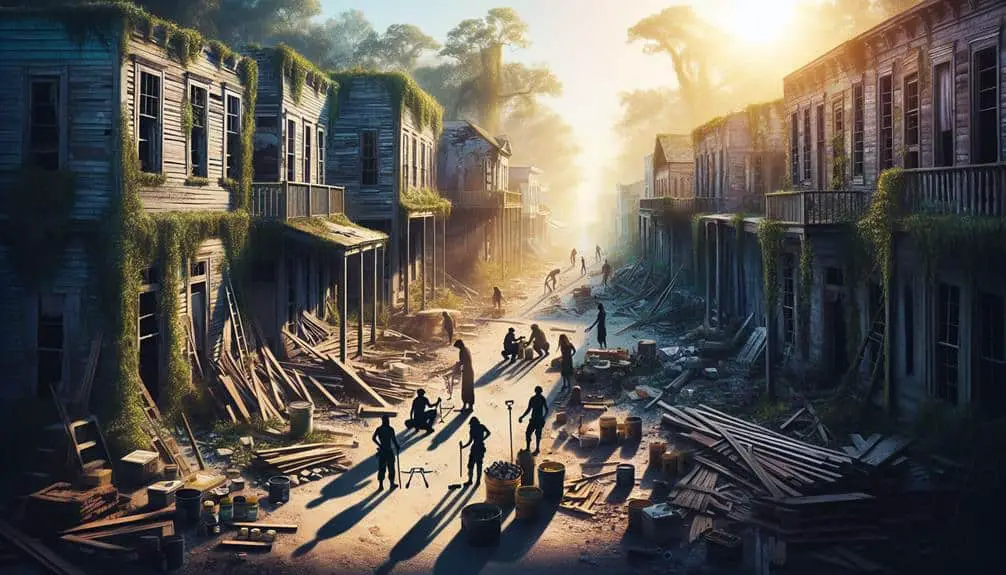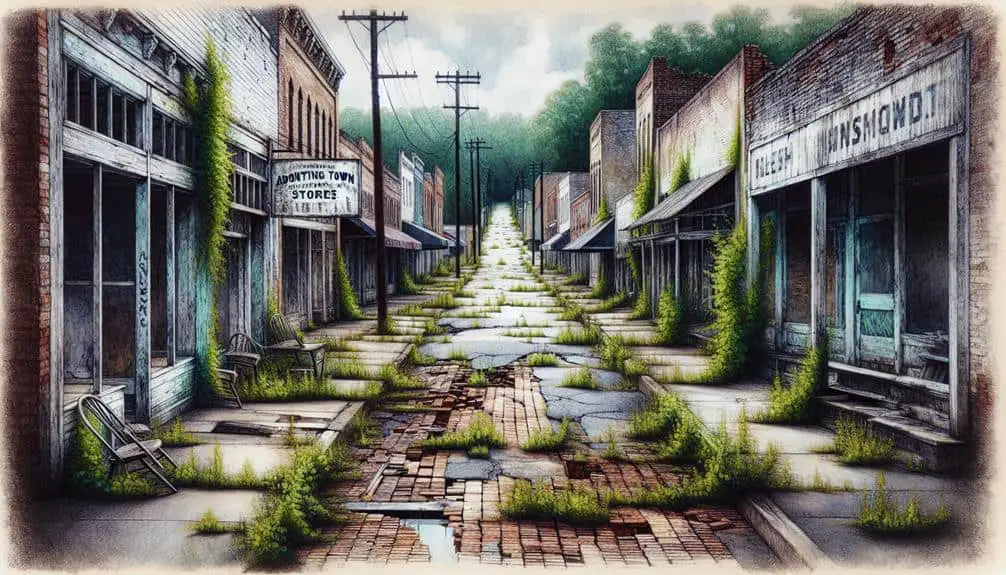To revive Southern ghost town communities, start by researching historical records for clues and analyzing economic decline causes. Conduct a needs assessment to understand challenges and engage with residents for insights. Engage local stakeholders, foster collaboration, and empower participation for successful rebuilding. Secure funding, recruit volunteers, and plan carefully for efficient project execution. Sustain rebuilt communities by involving residents in decision-making, diversifying economic opportunities, and investing in infrastructure. This guide offers a strategic roadmap for long-lasting impact and prosperous revitalization.
Key Points
- Conduct needs assessments to understand community challenges and opportunities.
- Engage local stakeholders for transparent communication and collaboration.
- Implement revitalization projects efficiently with diverse funding sources.
- Sustain rebuilt communities through community engagement and economic diversification.
- Invest in infrastructure and develop a sustainability plan for long-term prosperity.
Identifying Southern Ghost Towns
To effectively identify Southern ghost towns, begin by researching historical records and local archives for clues about abandoned settlements. Exploring history is important in understanding the economic impact that led to the decline of these communities. By delving into the past, you can uncover the reasons why these towns were established in the first place and what contributed to their eventual abandonment.
When researching historical records, pay close attention to any patterns or events that may have caused the economic downturn of these ghost towns. Factors such as changes in industry, natural disasters, or shifts in transportation routes can all play a significant role in the decline of a community. By analyzing these historical details, you can gain valuable insights into the economic struggles that these towns faced.
Local archives are treasure troves of information that can provide specific details about the businesses, infrastructure, and population of these ghost towns. By studying these records, you can piece together a detailed picture of what life was like in these communities during their prime and what ultimately led to their abandonment.
Understanding Community Needs
Exploring the essential requirements of the community is necessary for developing a thorough understanding of their needs. Carrying out a complete needs assessment will allow you to investigate deeply into the specific challenges and opportunities present in the community. Community engagement plays an important role in this process, as it enables you to interact directly with residents, local organizations, and leaders to gain insights into what matters most to them.
When engaging with the community, be attentive to their voices and concerns. Listen actively during meetings, surveys, and focus groups to capture a wide range of perspectives. By involving community members in the needs assessment process, you foster a sense of ownership and empowerment among residents.
To make sure the needs assessment is effective, utilize a mix of quantitative and qualitative data collection methods. Surveys can provide valuable statistical insights, while interviews and discussions offer nuanced understandings of individual experiences. By combining these approaches, you can create a holistic view of the community's needs, laying a strong foundation for the rebuilding process.
Engaging Local Stakeholders
Engage local stakeholders strategically to guarantee their active involvement in the community rebuilding process. When it comes to community involvement and stakeholder engagement, it's vital to take into account the following:
- Identify Key Stakeholders: Begin by identifying the key stakeholders in the community, such as residents, local businesses, community organizations, and government officials. Understanding their interests and concerns is essential to building a strong foundation for collaboration.
- Establish Clear Communication Channels: Create open and transparent communication channels to keep stakeholders informed about the rebuilding process. Regular updates, community meetings, and feedback sessions can help make certain that everyone is on the same page and has a say in the decision-making process.
- Encourage Participation and Ownership: Empower local stakeholders to take ownership of the rebuilding efforts by encouraging their active participation. Involving them in planning, decision-making, and implementation can foster a sense of ownership and pride in the community's revitalization journey.
Implementing Revitalization Projects
Implementing revitalization projects requires careful planning, coordination, and efficient execution to guarantee the successful transformation of Southern ghost town communities. To kickstart this process, you must first secure various funding sources. This could involve applying for grants specific to community revitalization, seeking private donations from local businesses or individuals passionate about historical preservation, and exploring public-private partnerships. Diversifying funding streams can guarantee long-term sustainability for the projects you undertake.
Next, volunteer recruitment plays an essential role in the implementation phase. Engaging with the community and recruiting volunteers who are committed to the cause can help spread the workload, foster a sense of ownership within the community, and bring diverse skills and perspectives to the table. Utilizing social media platforms, local community centers, and partnering with schools or universities can be effective ways to attract volunteers.
Sustaining Rebuilt Communities
To guarantee the longevity and prosperity of rebuilt communities, a thorough sustainability plan must be developed and meticulously executed. Community support plays an important role in ensuring the long-term sustainability of these revitalized areas.
Here are three key strategies to sustain rebuilt communities:
- Engage Local Residents: Actively involve community members in decision-making processes, encouraging ownership and pride in the revitalization efforts.
- Diversify Economic Opportunities: Create a robust economic foundation by fostering a mix of industries, tourism initiatives, and small businesses to reduce dependency on a single sector.
- Invest in Infrastructure: Develop and maintain essential infrastructure such as roads, utilities, and public facilities to support the growing population and attract further investment.
Frequently Asked Questions
How Can Historical Preservation Be Balanced With Modern Development in Rebuilding Southern Ghost Town Communities?
To balance historical preservation with modern development in rebuilding southern ghost town communities, focus on integrating historic structures into urban planning. Embrace adaptive reuse, zoning regulations, and community input to honor the past while fostering sustainable growth.
What Are Some Challenges Faced in Attracting New Residents to Revitalized Ghost Town Communities?
To attract residents to revitalized ghost town communities, focus on community engagement. Offer opportunities for involvement, showcase unique features, provide modern amenities, and emphasize the historical charm. By fostering a sense of belonging, you can create a vibrant and thriving community.
How Can Local Governments and Organizations Collaborate to Fund Revitalization Projects in Southern Ghost Towns?
To fund revitalization projects in southern ghost towns, local governments and organizations must foster public-private partnerships. By engaging with the community, these collaborations can leverage resources effectively, ensuring sustainable development and positive impact.
What Impact Does Revitalizing a Ghost Town Community Have on Surrounding Areas and Neighboring Towns?
Revitalizing a ghost town community acts as a beacon, drawing in economic growth like a magnet. The ripple effect spreads, engaging neighboring towns and fostering a sense of community ownership, leading to shared prosperity.
How Can the Unique Culture and History of a Southern Ghost Town Community Be Preserved and Celebrated in the Revitalization Process?
To preserve and celebrate the unique culture and history of a southern ghost town community in the revitalization process, consider integrating local traditions into new developments and creating cultural events that honor the area's heritage.



